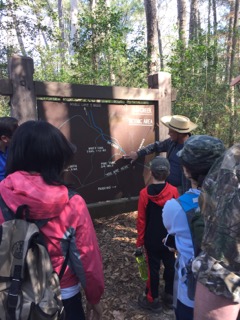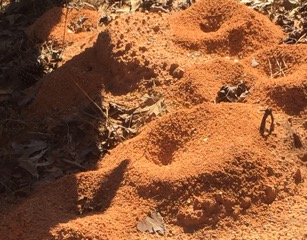The weather was beautiful as we motored away from Houston. Cloudy but with the sun peeking through periodically with a slight wind to keep the 60 degree chill in the air. Then I saw that fateful road sign: “:Freeway Closed in 20 Miles”. How could this happen when we were driving to meet other eager folks at 9 am to do a tour on the East side of Sam Houston National Forest?
It was 15 miles, 10 miles, 6 miles, 4 miles, and then we were in the crawling morass of vehicles. We crept along hoping that the Grand Parkway construction on U.S. 59 would not hold us up too long. Luckily, in about 10 minutes, we were through and our three car caravan reconstituted itself before we got to Cleveland, Texas, turned onto FM 2025 and rolled onto our rendezvous at the convenience store at the intersection of FM 945.
We arrived exactly at 9 am. A miracle given the traffic jam we had just gone through. There were about 10 people waiting for us but I knew there were more that were also probably delayed and would be late. Everyone headed to the bathroom, to get a snack, and signed  in and waited. Finally, about 30 minutes late all 27 of us got in our cars and headed north on FM 2025. This was a large group that I wanted to introduce to Sam Houston National Forest. We also had old-timers like Dave Wade with the Lone Star Hiking Trail Club and Allen Pape with the Lone Star Hiking Trail Conservancy who joined us for the day.
in and waited. Finally, about 30 minutes late all 27 of us got in our cars and headed north on FM 2025. This was a large group that I wanted to introduce to Sam Houston National Forest. We also had old-timers like Dave Wade with the Lone Star Hiking Trail Club and Allen Pape with the Lone Star Hiking Trail Conservancy who joined us for the day.
We first stopped at a roadside pull-off for the federally endangered Red-cockaded Woodpecker. This cluster (where the birds live) was made up of large pine trees in an open canopy that had just been burned. We saw a cavity tree and heard about the “family values” behavior that results in young male birds staying with their parents and helping raise chicks for several years. The periodic burning keeps the shrubs and hardwood vegetation down so that tall, old, pines are left for the bird to feed on.
We then took off and headed for Big Creek Scenic Area. We pulled into the parking lot and got ready for a short hike. We crossed a small, clear creek, near the beginning of the parking lot and then stood underneath American Beech, Southern Magnolia, White Oak, and other large hardwood trees. We found within a few steps the single leaf of the Southern Cranefly Orchid and when this leaf was turned over we saw the deep, rich, purple hue that told us it was a orchid and not a neighboring greenbriar.
We wandered up the trail and turned right, looked at the trail sign, and turned left and followed the trail toward Big Creek. We stopped and looked at the lower slope at the floodplain of Big Creek and found out that later in the year this area would turn into a thick, rich, green, fern-bed. We also smelled the leaves of Cherry Laurel and Red Bay and marveled at their distinctive and pleasant odors. I told everyone when I smelled these plants I drifted up into the air.
We admired Big Creek, a 6-10 foot wide, amber-colored sinuous stream. Watching Big Creek always makes me think of that Bob Dylan song where he sits down and watches “the river flow”. We headed up Pine Trail and watched for harbingers of spring. We found one! The beautiful, variegated tri-leaves of the Trilliun, like green and brown camouflage, looked like tattered, tiny, umbrellas. An unusual plant to find and usually indicative of a relatively undisturbed forest floor.
When we finished our hike in Big Creek Scenic Area we left some cars behind, carpooled, and took off to our next stop. We bumped along Forest Road 221 kicking up red dust as we drove. To our delight we met a two horse carriage with rubber tires, that was taking a Saturday ride along the road. We slowed down until the carriage passenger waved a red flag to signal we should pass, we slid by, and keep going.
Finally, we turned onto Forest Road 280 and then onto Forest Road 280D and the road got smaller and smaller until you could reach out and almost touch the nearby vegetation. We parked at a pipeline right-of-way and David talked about the Town Ant colony that was located right next to our cars. These ants had been very busy and large mounds of red soil were piled high. These mounds provided a home for thousands of ants that were out searching for seeds. 
We looked at a former oil/gas well pad that was slowly recovering after many years as trees and grasses grew into the opening that once held a monstrous derrick. We talked about how drilling for oil/gas was allowed on our national forests and that the Sierra Club pushed the U.S. Forest Service to ensure that any well, pipeline, road, or other facilities constructed due to such development were done in the environmentally least damaging manner. Then we walked down the pipeline and turned right onto another pipeline.
Almost immediately we started down a steep slope to a tiny stream, about one foot wide. This, I told my fellow adventurers, was a seepage creek that flowed due to water that percolated through the sandy upland soils until it hit a deeper clay layer and then flowed horizontally and seeped out at the bottom of the slope. Here a unique plant community of Sweetbay Magnolia, Gallberry Holly, Black Gum, Red Maple, Southern Magnolia and rare orchids and saprophitic plants, like Nodding Nixie, grew. A giant “Old Southern Magnolia” towered over this area and provided a dark, shaded, canopy. The name of this unique plant community is “baygall” in honor of the Sweetbay Magnolia and Gallberry Holly that grows here.
We retraced our steps, hiked down Forest Road 280D, and turned left onto the Lone Star Hiking Trail. We followed the trail until it dropped into a valley where another, beautiful, clear, seepage creek flowed. We stopped at a bridge and admired the scenery. I encouraged everyone to get involved in the upcoming months as the U.S. Forest Service began its process to rewrite its current land management plan which has not been revised in 20 years. We need to continue the protection of sensitive places like this seepage creek.
We drove back to Big Creek Scenic Area, picked up the cars that we had left behind, and then drove to the Winters Bayou Scenic Area. As we drove we crossed the East Fork of the San Jacinto River and its floodplain, which flows south and empties into Lake Houston.
We arrived at Winters Bayou Scenic Area about 1:30 pm and I could tell everyone was getting a bit “restive” because they were hungry and we had not had lunch. I wisely kept my talk to a minimum and we walked past Southern Magnolia, White Oak, Red Maple, fields of Palmetto, sloughs, and large Loblolly Pines until we got to the Winters Bayou Bridge. We watched the water flow down Winters Bayou for a short time and then hiked back.
We were through with our tour but then drove into Cleveland and had lunch at China One Buffet. There were many stimulating discussions at lunch and we sated ourselves with our late buffet lunch.
Finally it was time to go home. I was tired but felt my spirits uplifted. You can never go wrong taking a stroll through Sam Houston National Forest.
Brandt Mannchen
February 14, 2016